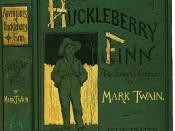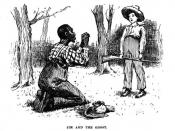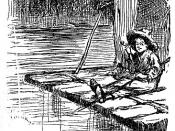Huckleberry Finn, a tale about a boy and his struggles with the society in which he lives, is written by Samuel L. Clemens. In the story, Huck manages to escape from the custody of Widow Douglas and travels down the river to a nearby island where he encounters Miss Watson's runaway slave, Jim. Together, they float down the Mississippi River, to find a new life, where they can live freely and easily. The Adventures of Huckleberry Finn is perhaps the finest example of "local color"ÃÂ, an emphasis which is laid on the surrounding settings. Throughout the novel, Clemens accents "local color"ÃÂ by illustrating the natural scenery, the way of thinking, and the distinct practices and folklore encompassing the area.
The novel's plot revolves around the Mississippi River. The river breaks all the barriers of the time period, between black and white, young and old, slave and free. With their many journeys on land, they invariably return at the raft.
While stopped in a near by village, Huck and Jim manage to escape the king and the duke, seeking refuge on raft. "It was the raft, and mighty glad was we to get aboard of it again"ÃÂ(Clemens 1309). Later on in the novel, at the Phelps Farm plantation, Tom and Huck learn that Jim is held captive in a hut just beyond Aunt Sally's house. They devise a scheme to get him out, involving digging a tunnel, sawing off a leg of a bed which Jim was chained to, using a rope ladder, and having Jim flee from a makeshift window. The plan runs smoothly, all three exiting through the man made hole, until Tom gets caught on a piece of wood, which creates a clamorous noise. At that moment, they began their retreat in a hurry. Fifteen men, equipped...


